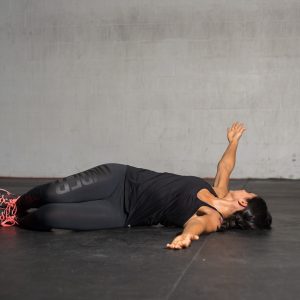We know that mobility training is crucial for all of us. We see the hundreds of mobility articles, videos, and posts about this and that drill.
But do we know how to piece it all together?
For years I’ve tinkered with different mobility techniques with my clients and myself, and quickly realized that mobility training is always fluid and evolving.
Sounds like fitness in general, am I right?
The Cliff Notes on Mobility Training
Before we get into the nuances of piecing together a mobility plan that fits our lifestyle, goals, and needs, I feel it’s important that we understand why mobility training is so critical.
I see far too many people devote 30+ minutes to mobility work before or after a training session every time. As in, every single lifting session!
If you have time to kill, you have my blessing, but this is no way to approach your mobility training forever.
Mobility training should be short, purposeful, and to the point. It should complement your workout, meaning you can easily incorporate it into the training session without it taking over, and it should address a specific set of weaknesses or problem areas affecting your performance. Sometimes mobility training is a form of corrective exercise, and other times it’s not.
Ideally, your mobility work should address all of the following:
- Soft tissues work
- Breathing
- Dynamic stretching
- Stabilization
- ROM
You may not hit all areas in a single training session, but it is possible to get in at least four of these in before, during, or after a workout.
Soft Tissue Work
Start your workouts with a brief soft tissue release work. This usually involves foam rolling or lax ball work. It should address specific areas you’ll be targeting during your workout, or areas that are significantly stiff. Most common areas in need of some soft tissue work: Chest, lats, glutes, quads, calves, and spine.
Total time: >2 minutes
Breathing
There are two ways to incorporate a breathing drill into your routine: Do a single drill in your warm-up or do some Pilates exercise that incorporates breath work and movement, like the Hundred.

Quite frankly, I stick with Pilates on this one because I can usually hit 2-3 birds with one stone. For example, the Hundred incorporates breath, T-spine flexion, and core work into a single movement. The Roll-up, Rolling Like a Ball, and Single leg stretch do the same.
The purpose of your breath work is two-fold: 1.) It relaxes the body so you can get your mind right for the workout, and 2.) It takes you out of the dysfunctional breathing patterns that contribute to more dysfunction up and down the body.
My free warm-up guide offers a bonus Pilates-based mobility flow for the hips and spine. You can start there and make sure to follow the breathing patterns.
Total time: >1 minute
Dynamic stretching
We can sit here and argue for or against static and dynamic stretches all day, but I’ll spare you. Part of your mobility approach is to move through your ROM. That means instead of holding a stretch the way you’d hold a pose in yoga, you are warming up the exact muscles you aim to target in the workout to improve the overall quality of movement.

This is one of the most important aspects of your mobility approach, yet so many people hit the gym with the same 4-5 stretches they’ve been using since middle school.
Ugh.
If you’re still lost on which dynamic stretches fit into your workout, download my free Warm-up Guide.
Total time: 5-8 minutes
Stabilization
The mobility movement has been great for all athletes and coaches, but we’re still forgetting that stability is a part of great mobility.
During an exercise, there are primary movers and stabilizers. A weakness or dysfunction in one of your stabilizers means the body has to compensate elsewhere to make up for it. Obviously this causes a lot of problems.
The shoulder and hip complex are two areas in which the industry seems to overemphasize mobility and not stability. I get it; this tends to be a complicated, stiff areas. However, a lot of the injuries I’ve experienced or have seen in my clients started because of a lack of stability. For hypermobile women especially, I have to overemphasize stability or else I get limbs going all over the place. It’s not just about achieving a full range of motion in these areas, it’s also about creating stabilization so that you can achieve a safe, pain-free range of motion for the long, long haul!
Total time: >5 minutes
I recommend doing at least two stabilization exercises for every mobility exercise per body part to start.
ROM
Range of motion goes hand in hand with stabilization and the dynamic stretches. If you’re just swinging limbs around in your dynamic stretches, then you’re not really enhancing your ROM.
Instead, focus on controlling your movement and trying to achieve full ROM. Quit doing leg swings before a squat day or rushing through drills like you’ve got someplace else to be. You are here, right now, ready to train. Put your focus in controlling ROM.
Total time: depends on the exercise
Creating your Mobility Plan
Mobility is important but don’t let it take over your training session. To get started here some questions to answer:
What is the focus of my workout?
What weaknesses do I currently have that might interfere with my performance for this workout?
Where do I feel tight or stiff the most?
Do I sit or stand most of the day?
From there you can piece it together like this:
WARM-UP:
- 8-10 exercises or drills
- List 1 for breathing, 2 for stabilization, 4-6 exercises that address mobility and ROM
- 3-4 soft tissue exercises that you need for the day
ACCESSORY WORK:
Sometimes you need to emphasize a bit more mobility work within the training itself in order to see real improvements. Here are two ways I like to do that:
- Superset your first compound lift with one mobility or stability exercise. For example, after a squat you can perform a T-Spine Windmill, banded clamshell, or Hip CARs.
- Add one stabilization exercise into the rest of the workout as part of the circuit or superset, like a Pallof press, Hollow Rock Iso Hold, or Plank with elbow taps
REST TIME:
Make the most of your rest time in between big lifts either by foam rolling or adding in another mobility drill as needed. I got this idea from Dan John years ago.
For example, if your first exercise is barbell deadlifts at 80% (we going heavy, fam!) your “rest time” between sets might be around 2-5 minutes. Instead of sitting around playing on your phone, use that time to foam roll the T-Spine, activate the glutes with glute bridges, or do some resistance band pull downs for lat activation…all of these offer a significant boost to your deadlift without fatiguing you for the next set.
Creating a mobility plan doesn’t have to be complicated. Identify what your needs are, and then write down a simple plan before, during, or after your workouts. It always helps to incorporate mobility training on your off-days too. If that’s realistic for you, then do it but don’t feel like you have to. This is about taking an approach that you can implement, just like a diet or workout. Do what fits into your life!

